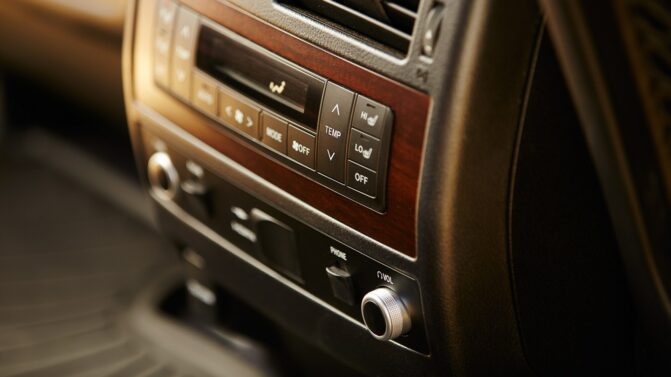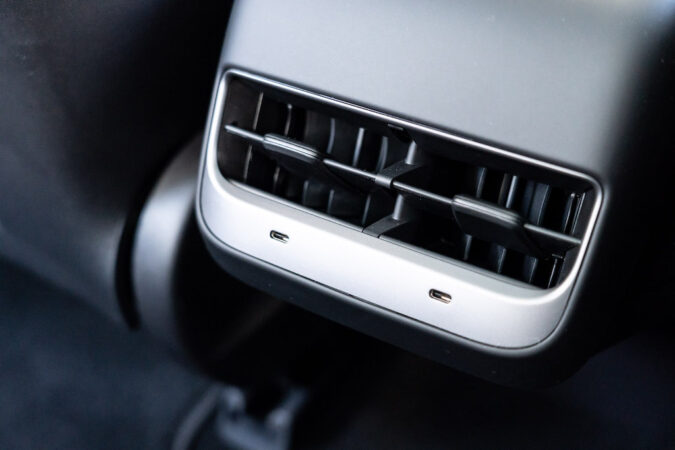The resistor is a passive electronic component that is well-known for being utilized in a variety of electrical and electronic circuits. Depending on the need, various resistor types are available and utilized. One of the varieties of them is the blower motor resistor.
In autos, heating and air conditioning are utilized in tandem to create the necessary air temperature. Blower resistors are crucial components in these systems. An overview of its operation and the 7-wire harness diagram is included in this article.
- Overview
- Where is it Located?
- How to Diagnose it?
- Specifications
- Wiring Diagram
- Reasons for Faulty Blower?
- What are the Symptoms?
- How to Run the Test?
- How to Replace it?
- How much does it Cost?
Blower Motor Resistor
Every time you switch on the heat or air conditioning in your vehicle, a fan blasts the air into the cabin where you are, making it operate. Due to its seeming simplicity, it is one of the systems in your car that is most frequently taken for granted.
After all, a fan is a simple piece of equipment in the eyes of the majority of people. Push the button to start a breeze and some metal blades spin. It’s not at all difficult to grasp.
Your Vehicle’s Air Circulation System
Every vehicle’s air circulation system operates on the same fundamental principles. The component of the blower motor that regulates speed is the resistor. The resistor instructs the blower motor to accelerate and blow more air when you turn up the air conditioner’s knob. The reverse occurs when the volume is lowered.
A Crucial Electrical Component
It is an electrical component, and in order for it to function, electrical impulses must be sent that correspond to the data you provide by turning the dial. The electrical signal changes, which has an impact on the fan’s overall motor speed. In terms of electrical systems, they are straightforward, but as you can see, if something disrupts the flow of power, problems could arise.
It’s important to keep in mind that the blower motor resistor won’t have any power when the fan is entirely turned off. And in many cars, you won’t use the motor resistor at all when the fan is fully turned on because, at that moment, it is not necessary to control the flow of power.
Only when the blower motor is halfway between entirely off and fully operational does it need to perform its function.
Experience With Few Issues
Blower motor resistors can experience a few issues that will impair their performance. For instance, it may deteriorate if moisture enters it. Corrosion prevents it from effectively controlling the current, which prevents it from communicating the right commands to the blower motor.
Consequently, it’s possible that you won’t be able to modify the fan’s power. And in the worst-case circumstances, your fan won’t function at all because it won’t send any signal at all. Other than rust, it could just have mechanical damage, as if you were in an accident and the resistor somehow broke.
Blower Motor Resistor Location
The blower motor resistor keeps the electric fan cool while it is running by working between the heater, AC, and electric fan controls. It is normally found under the dash, on the other side of the steering wheel, and close to the electric fan.
Blower Motor Resistor Test
Diagnostic techniques differ. Frequently, a simple visual inspection discloses the issue. For instance, rusting can be seen, which causes it to fail. The resistance between the terminals must be tested and compared with specifications if the resistor has no visible damage. The resistor needs to be changed if the resistance is not within specifications.
For instance, we measured the resistance of the resistor for the blower motor. The service handbook specifies that it should be between 4-5 ohms. The ohmmeter in our situation displays an open circuit, indicating that the resistor has failed.
A blower motor resistor may occasionally malfunction as a result of issues with the blower motor itself. This indicates that you should check to see if the blower motor functions smoothly and without making any noise after replacing one.
It has happened before that a newly replaced resistor will start to malfunction again due to a worn-out blower motor. For instance, older Chrysler and Dodge minivans frequently experienced this problem.
In this instance, replacing the blower motor is also necessary. One of the signs of a worn-out blower motor is the ability for it to occasionally make a loud screaming sound while operating.
Specifications
The following are the characteristics of a blower motor resistor.
- The motor utilized in this is a DC series motor.
- The resistor for the blower motor weighs about 1.5 pounds.
- Reliable and of good quality.
- The blower motor may operate at a maximum power of 27 kW.
- They are durable and finished to a high standard.
- It consists of four poles.
- It is rated at 1750 RPM.
- A DBR fan is used to cool the surface.
- Upright mounted.
- There are four brush holders in it.
- Type H insulation.
- The motor’s armature temperature is 80 ºC
- It is 85 ºC in the commutator.
- 90 ºC is the highest absolute bearing temperature.
Blower Motor Resistor Wiring Diagram
The connection between the resistor and an automobile can be shown using a wiring diagram.
The switch of a fan can power the blower motor, and the resistor has the highest fan speed setting that will be bypassed in this car. Therefore, even if this resistor is faulty, the motor in some cars may continue to run at its full speed.
As shown in the image above, if the fan switch is in the “1” position, three series-connected resistors (R2, R3, and R4) can be used to reduce the current flowing through the motor. The current flow from the power source to the motor and, subsequently, the fan switch using an available wiring diagram.
Similarly to this, when the fan switch is in position “2,” two resistors are linked in series, and in position “3,” there will only be one resistor. The current flow inside the circuit is reduced when resistance is added to a circuit.
The total resistance will increase and be equal to the sum of the independent resistances when a number of resistors are connected in series.
Reasons For A Faulty Blower Motor Resistor
Resistors have a hard time. They are always powered by electricity, and the voltage might shift dramatically as the blower fan’s power is changed.
The following are the most likely causes of blower motor resistor failure:
- Prolonged exposure to air and moisture causes corrosion.
- Overheating: If a motor is slowed down or has worn-out bearings, this might cause the resistor to overheat to dangerous levels.
- Normal wear and tear is caused by time and use.
Blower Motor Resistor Symptoms
The typical blower motor resistor symptoms might warn you of the possible problem.
1. The Blower Motor Is Stuck At A Single Speed
The resistor becoming stuck in one position is one of the most typical signs of a faulty resistor. It’s directly in charge of regulating the blower motor fan’s speed. If the motor resistor fails, the blower motor may become stuck at a specific speed.
Although the blower motor resistor has to be replaced, the heater and air conditioner are still functional. Furthermore, a jammed blower motor may be caused by other defective HVAC components.
2. There Is No Air Coming From A Car’s Vents
Not being able to obtain air from the vents of the automobile or having a poor car air conditioner are further signs of a failed blower motor resistor. However, if you are only getting little to no air from the vents, there may be an issue with it. The resistor is responsible for sending enough power to move the air with particular pressure.
3. In Some Configurations, The Blower Motor Is Inoperative
Furthermore, another common sign of its failure is that the motor does not work in certain conditions. This occurs when the blower motor resistor’s internal parts break down, causing the motor to completely stop functioning on one or more settings.
A malfunctioning switch may also be to blame for the blower motor not operating in some circumstances. The switch’s purpose is to regulate the operation of the blower motor resistor. Thus, if you are unsure about the precise problem, a proper diagnosis is advised.
4. Inability To Turn Off The Fan
It’s a sign that it isn’t effectively regulating the electrical current if your fan won’t shut off no matter what you do and keeps running whether you try to switch it up, down, or off.
5. Smoke Vents
Although it’s uncommon, this could be a sign of a bad blower motor resistor. It could experience a shortage of some kind, which could cause wires to begin melting. If this happens, the fan may blow the smoke produced by the melting wires back into the car’s cabin.
A decent rule of thumb is to pull over right away and assess the situation if any smoke begins to enter your automobile through the vents. If it isn’t the problem, it might be something more serious, and you should seek medical attention right once.
6. Burning Odor
Similar to the smoking vent problem, occasionally, there isn’t real smoke billowing into the car’s interior, but you will still detect the characteristic burning smell that indicates some metal or plastic is scorching inside the car. This frequently occurs together with one of the other symptoms we’ve already mentioned.
How Do You Run A Blower Motor Resistor Test
The good news is that by performing a certain blower motor resistor test, you may determine that the issue is with it and not with another component. To blower motor resistor test, follow these steps:
1. Find The Fuse For The Blower Motor Resistors
Finding the fuse at the blower motor resistor location in your car should be your initial step. You may find out where this fuse is in your car by consulting the owner’s manual, watching some YouTube videos, or conducting a Google search.
You can always acquire a printed copy of the handbook from your qualified mechanic or download it from the Internet if you don’t already have one.
2. Examine The Blower Motor Resistor Fuse
The next step is to check to see if the blower motor resistor fuse is functioning properly after it has been identified. Use a 12-volt test light and attach one side to the ground and the other to the fuse terminal to do this.
Observe how the power behaves on the terminals to check if the fuse is functioning properly. The fuse should be in perfect working order if both terminals are powered. If they don’t have power, though, the fuses burn out and need to be replaced.
3. Perform Blower Motor Resistor Test After Removing It
Make careful you unhook the blower motor and attach it to the 12-volt test light. It’s crucial to conduct the test in this manner to avoid misunderstanding caused by parts of your car’s climate control system.
When carrying out the operation, it’s crucial to adjust the blower motor to various speeds to see whether there are any issues at particular rates. You’ll notice that the blower motor loses power at particular speeds if it isn’t operating properly.
Remember that if you turn the blower motor up to its highest setting and discover there is no power, the issue may also be related to a defective switch because, at some high speeds, the blower motor receives its power from the switch.
If you notice that the blower motor operates flawlessly at higher speeds but not at lower speeds, the issue is likely with the resistor that controls the blower motor.
4. Run A Blower Motor Ground Test
Blower Motors depend on specific grounds that are attached to the body of the vehicle, and occasionally a defective blower motor can result from an issue with the ground itself.
Your blower motor may operate erratically as a result of rounds wearing out over time. In the event that none of the aforementioned tests revealed a problem with the blower motor resistor, you should check the blower motor ground as it can be the problematic element.
Blower Motor Resistor Replacement
The simple procedures for changing one are as follows:
Step 1: Identify The Blower Motor Resistor
Locating the blower motor resistor is obviously the first thing you should do so that you can decide which component will be removed. It is just adjacent to the blower motor. The latter, on the other hand, is typically discovered in the engine compartment or beneath the passenger-side dashboard.
Step 2: Eliminate The Blower Motor Resistor
Now that you are aware of its location, remove it. Start by removing the parts around it, such as the pigtail attached to the AC and the cooling duct. The blower motor resistor may now be easily accessed.
The bolts holding it in place just need to be unscrewed. Tighten the screw using a ratchet with a brief extension. The blower motor resistor must only be removed after the bolts have been removed.
Step 3: Unplug The Wires
Cut the wires that link to the blower motor resistor after removing it. Use a wire-cutting stripper or pair of scissors to cut the wires.
Step 4: Setup The New Blower Resistor
Before beginning the installation, lubricate the casing of the blower motor resistor with dielectric grease. It will prevent water from getting inside the car, which is a regular problem when traveling off-road. To seal off the plastic and safeguard the component, apply a coating around it.
Reinstall the blower motor resistor in the same spot where it was removed. To keep them in place, replace the screws. Once the job is complete, connect the pigtail. There are other circumstances, though, where the pigtail is already worn out. If this is the case, move on to the following step.
Replace the new wires after disconnecting the old ones. This should be easy because the cables are likely color-coded. The new wires should be connected to the connections. You complete the task when you put the pigtail back in its proper place.
Blower Motor Resistor Cost
Depending on the type of vehicle you drive, the cost for repair could range from $10 to $60. This is one of the less expensive components of an air conditioner or heater to replace. A faulty heater fan can frequently cause the heater to malfunction, necessitating a replacement and fan.
Furthermore, changing the part is not a difficult task. The diagnosis process could take longer than simply changing the resistor. If you’re not confident doing it yourself, you’ll need to hire a qualified mechanic to complete the task.
Depending on where you reside, and the car you drive, the replacement costs more labor than buying one. It’s a good idea to shop around because you might get a variety of bids, some of which are nearly double the price of another service.
To replace one, you should typically budget between $50 and $200 for labor, bringing your total to between $60 and $260 for supplies and labor.
Can You Drive Without A Blower Motor Resistor
You can drive without one, but it’s risky. The electricity to run the fan and expel the surplus heat from your engine comes from the blower motor resistor. You can only obtain one working engine fan if it breaks. The engine can’t be cooled down with this amount.
The engine will become overheated after an hour of continuous driving, and the blower motor won’t be able to remove the heat.
As a result, the engine power will be harmed by overheating and become less effective. Your car’s engine will sustain serious harm if you keep driving for hours. After a few hours, your engine may shut down, and the fan may immediately blow up.
As a result, you will experience a new crisis. It’s preferable to keep driving after disabling the resistor. You can achieve your goals best through bypassing. You should not, however, operate your vehicle without one. It will cause issues, harm the engine, and compromise the overall cooling system.
Frequently Asked Questions
How To Test A Blower Motor Resistor
You can use a multimeter to quickly test the blower resistor by measuring each resistor’s resistance as follows: Set the instrument to read ohms (a unit of resistance measurement) and join one of its probes to the resistor’s common output terminal. The resistance between each input terminal of the resistor and its output terminal should be measured using the other probe. One terminal pair at a time is used to measure the resistance.
What Does A Blower Motor Resistor Do
Blower motor resistors regulate the electrical current that travels from the fan switch to the blower fan, enabling the driver to adjust the speed of the fan.
How To Replace A Blower Motor Resistor
Find the resistance for the blower motor. Now you must unplug the resistor from the housing and take the harness off. The blower motor resistor will simply slip out of the HVAC enclosure once the wiring harness has been disconnected. The new resistor can now be installed. Ensure that you remove the old gasket as well if the new resistor you purchased includes one. Check the blower motor’s performance after installing the new resistor. If the results meet your expectations, rejoin the wiring harness and put it in its original blower motor resistor location.
Can You Bypass A Blower Motor Resistor
You have the option of bypassing the blower motor system and allowing the machine to provide direct power without any control. Due to problems with the internal wiring, the blower motor may occasionally become damaged and stop functioning. In that scenario, you must secure the electric flow and bypass the blower motor.
Final Conclusion
Despite being a very small component of an air conditioning or heating system, the blower motor resistor plays a crucial role. It regulates the blower motor fan’s speed and is the part that is most susceptible to wear and tear over time. You need a repair right away if it becomes faulty. Otherwise, your heating and air conditioning systems won’t function.
After that, it is advised that you quickly fix the blower motor resistor. However, it might not even be worthwhile spending money to try to fix it if your car also has additional, more severe issues with the engine or gearbox.




